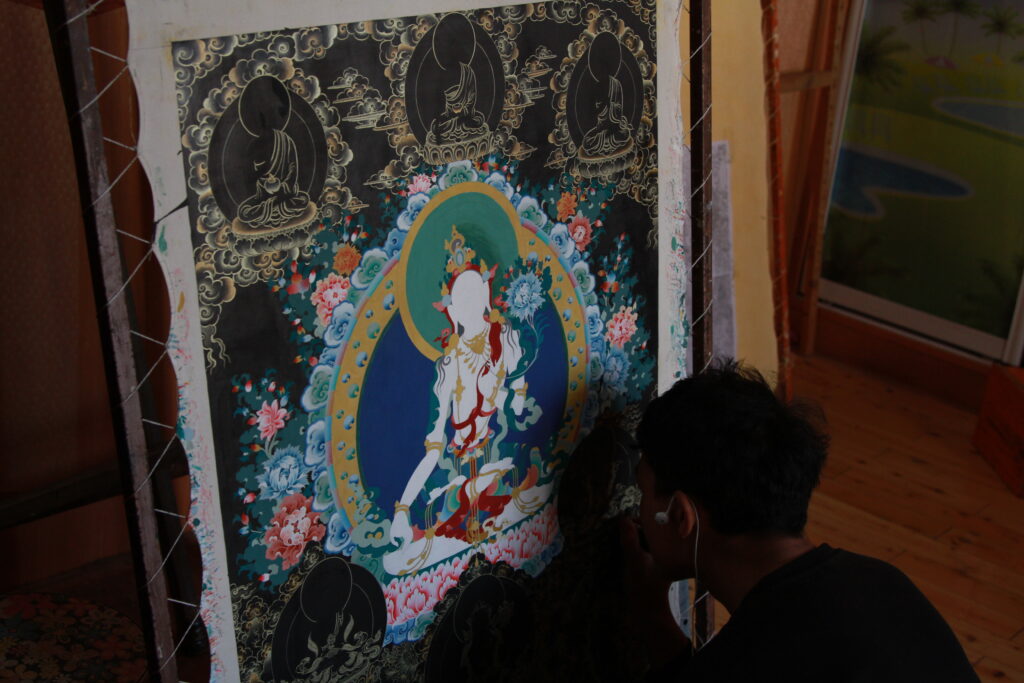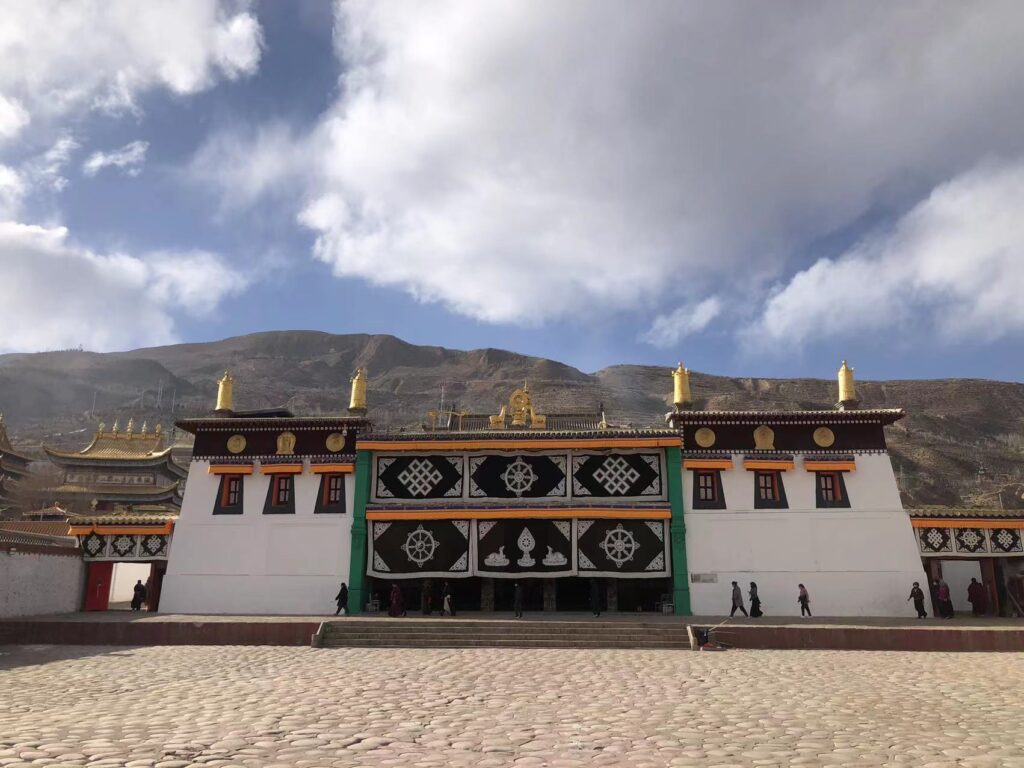Amdo Rebkong (known today as Tongren County in Huangnan Tibetan Autonomous Prefecture, Qinghai Province) is a culturally vibrant Tibetan area within the Amdo region, one of Tibet’s three traditional regions. Amdo Rebkong is renowned for its rich Tibetan Buddhist heritage, particularly through its unique form of religious art called Rebkong Art—a distinct style of Thangka painting, murals, and sculptures. This art form has gained international recognition, with UNESCO listing it as an Intangible Cultural Heritage.
In addition to its artistic and cultural heritage, Amdo Rebkong hosts numerous Tibetan monasteries and vibrant festivals, making it a significant spiritual and cultural hub in the Tibetan plateau.

Rebkong Art
Rebkong Art refers to the exquisite Thangka paintings, murals, and sculptures that originated in the Rebkong area. This traditional art is practiced by generations of Tibetan families, and it incorporates intricate patterns and vibrant colors that depict Buddhist deities and spiritual scenes.
Visitors can witness artisans working on Thangkas in their studios, as well as see completed works in monasteries throughout the region. The meticulous skill and devotion that goes into each piece make Rebkong Art a treasure of Tibetan culture.
Rongwo Monastery

Rongwo Tosam Namgyel Ling or also called Rongwo Gonchen monastery is the principal monastery of Rebkong, The original temple was founded in 1301 by the Sakya master Samten Rinchen who was the eldest son of Dodebum, the ruler of Rebkong. Originally a Sakya monastery, it was converted to the Geluk tradition in 1630 by Shar Kelden Gyatso. The complex currently has nine temples and around 600 monks headed by the important incarnated Lamas of Rongwo, The principal tulku is the eighth Rebkong Kyabgon. There are 35 branch monasteries, most of them are in Rebkong county. Rongwo Gonchen has four major colleges, including a meditation hermitage called Drundra Nechok Tashi Kyil. And the others were dialectical colleges known as Dratsang Tosam Namgyeling, which was founded by Shar Kalden Gyatsoin 1630, the tantric college known as Gyudra Sangchen Chokyi Bangzo, which was founded by the second Shartsang Ngawang Trinley Gyatso, and the Kalachakra college known as Dudra Sangak Dargyeling, which was founded in 1773 by the third Shartsang Gendun Trinley Rangye. Among the recently renovated buildings at Rongwo Gonchen, the great assembly hall is close to the main road just behind the Haryagriva hall. There two other significant temples near the assembly hall are Mipham Chokyi Podrang dedicated to Maitriya and the Dolma Lhakhang to green Tara. The monastic college is situated further to their right. To the south and slightly uphill from the great assembly hall is the Khardong Chapel, containing the reliquary stupa of the seventh Rongwo Kyabgon Shartsang. The renovated Kalachakra college lies behind it. Far to the right of the Kalachakra college is the Jampeyang Lhakhang with its distinctive roof, it contains an exquisitely fashioned clay image of Manjughosa, which exhibits all the best hallmarks of Rebkong clay sculpture. Above this temple is the Podrang or the residence of the present eighth Rongwo Kyabgon.
Display of Giant Thangka Painting
Known locally as the “Thanka Display Festival,” this ceremony is a highlight of the Tibetan New Year (Losar) celebrations. During the event, monks unfurl a massive Thangka painting on a nearby hillside, allowing pilgrims and visitors to view the large image.
The festival draws large crowds, and touching the displayed Thangka is considered a way to receive blessings for the coming year. The ceremony includes prayers, traditional songs, and dances, creating a deeply spiritual and culturally immersive experience.
Gomar Monastery
Situated near the town of Rebkong, Gomar Monastery is known for its stunning architecture and red gates. It is also part of the Gelugpa school and shares in many of the region’s religious festivals.
The monastery is renowned for its annual Cham dance during the Tibetan New Year, where monks perform sacred masked dances representing Buddhist deities and historical events. The Gomar Cham Dance is especially revered as an ancient practice that has been preserved for centuries.
Wutun Monastery and Wutun Village
Wutun Village is the artistic heart of Rebkong, where most residents are skilled in Rebkong Art. The village is home to Wutun Monastery, known for its architectural beauty and elaborate murals.
In addition to visiting the monastery, travelers can tour local artists’ homes and watch as they create intricate Thangka paintings. The village atmosphere, filled with color and artistry, provides a deep connection to Tibetan Buddhist culture.
Cham Dance Festival
The Cham Dance, a sacred ritual dance, is a significant part of the Monlam Festival and other religious events in Rebkong. The dance symbolizes purification, the removal of obstacles, and the blessing of the environment and community.Highlights: Cham dancers wear elaborately decorated masks and costumes and perform to traditional Tibetan music. The dances, accompanied by religious chanting and instruments, offer a captivating glimpse into the spiritual practices of Tibetan Buddhism.
Administrative Divisions of Huangnan (Rebkong) Tibetan Autonomous Prefecture
| Serial No | Name of Counties | Name in Tibetan | Area (km2) |
| 1 | Tongren (Rebkong) | རེབ་གོང་གྲོང་ཁྱེར། | 3465 |
| 2 | Jianzha (Chentsa) | གཅན་ཚ་རྫོང་། | 1712 |
| 3 | Zeku (Tsekog) | རྩེ་ཁོག་རྫོང་། | 6494 |
| 4 | Henan (Sogwo) | རྨ་ལྷོ་སོག་རིགས་རང་སྐྱོང་རྫོང་། | 6250 |
Tips for Visiting Amdo Rebkong
Plan to visit during major Tibetan festivals such as Losar (Tibetan New Year) or Monlam, which usually occurs after Losar. These festivals showcase the most vibrant cultural and religious activities.
Rebkong is situated at around 2,480 meters (8,136 feet) above sea level, so some travelers may experience mild altitude sickness. Acclimate by taking it easy for the first day, staying hydrated, and avoiding strenuous activity.
When visiting monasteries, dress modestly and maintain quiet respect. Refrain from touching sacred objects or photographing inside temples without permission.
Rebkong has a range of guesthouses and small hotels. For an authentic experience, consider staying in a Tibetan guesthouse, where you may have the chance to connect with local families and enjoy traditional Tibetan hospitality.
 Tibet World Travel Tibet Tour, Tibet Trip, Tibet Travel, Tibet Train, Tibet Trekking,
Tibet World Travel Tibet Tour, Tibet Trip, Tibet Travel, Tibet Train, Tibet Trekking,
